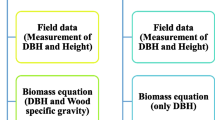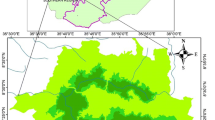Abstract
Biomass estimation using allometric models is a nondestructive and popular method. Selection of an allometric model can influence the accuracy of biomass estimation. Bangladesh Forest Department initiated a nationwide forest inventory to assess biomass and carbon stocks in trees and forests. The relationship between carbon storage and sequestration in a forest has implications for climate change mitigation in terms of the carbon sink in Bangladesh. As part of the national forest inventory, we aimed to derive multi-species biomass models for the hill zone of Bangladesh and to determine the carbon concentration in tree components (leaves, branches, bark and stem). In total, 175 trees of 14 species were sampled and a semi-destructive method was used to develop a biomass model, which included development of smaller branch (base dia < 7 cm) biomass allometry and volume estimation of bigger branches and stems. The best model of leaf, branches, and bark showed lower values for adjusted R2 (0.3152–0.8043) and model efficiency (0.436–0.643), hence these models were not recommended to estimate biomass. The best fit model of stem and total aboveground biomass (TAGB) showed higher model efficiency 0.948 and 0.837, respectively, and this model was recommended for estimation of tree biomass for the hill zone of Bangladesh. The best fit allometric biomass model for stem was Ln (Stem) = − 10.7248 + 1.6094*Ln (D) + 1.323*Ln (H) + 1.1469*Ln (W); the best fit model for TAGB was Ln (TAGB) = − 6.6937 + 0.809*Ln (D^2*H*W), where DBH = Diameter at Breast Height, H = Total Height, W = Wood density. The two most frequently used pan-tropical biomass models showed lower model efficiency (0.667 to 0.697) compared to our derived TAGB model. The best fit TAGB model proved applicable for accurate estimation of TAGB for the hill zone of Bangladesh. Carbon concentration varied significantly (p < 0.05) by species and tree components. Higher concentration (48–49%) of carbon was recorded in the tree stem.


Similar content being viewed by others
References
Akhter M, Jalal R, Costello L, Rahman L, Tasnuva U (2016) Zoning for tree and forest assessment in Bangladesh. Bangladesh Forest Department and Food and Agricultural Organization of the United Nations, Dhaka, Bangladesh, p 36
Allen SE (1989) Chemical analysis of ecological materials. Blackwell Scientific Publications, Oxford, p 565
Alvarez E, Rodríguez L, Duque A, Saldarriaga J, Cabrera K, de las Salas G, del Valle ILA, Moreno F, Orrego S (2012) Tree above-ground biomass allometries for carbon stocks estimation in the natural forests of Colombia. For Ecol Manag 267:297–308
Basuki TM, van Laake PE, Skidmore AK, Hussin YA (2009) Allometric equations for estimating the above-ground biomass in tropical lowland Dipterocarp forests. For Ecol Manag 257:1684–1694
Birigazzi L, Javier GP, Gamarra Gael S, Stefano G, Emily D, Julian M, Matieu H, Nicolas P (2015) Toward a transparent and consistent quality control procedure for tree biomass allometric equations. In: XIV World Forestry Congress, vol 7, no 11. Durban, South Africa
Brown S (1997) Estimating biomass and biomass change of tropical forests: a primer. FAO Forestry Paper, vol 134. Rome, p 55
Brown S, Gillespie AJR, Lugo AE (1989) Biomass estimation method for tropical forests with applications to forest inventory data. For Sci 35:881–902
Chave J, Andalo C, Brown S, Cairns MA, Chambers JQ, Eamus D, Folster H, Fromard F, Higuchi N, Kira T, Lescure JP, Nelson BW, Ogawa H, Puig H, Riera B, Yamakura T (2005) Tree allometry and improved estimation of carbon stocks and balance in tropical forests. Oecologia 145:87–99
Chave J, Réjou-Méchain M, Búrquez A, Chidumayo E, Colgan MS, Delitti WB, Duque A, Eid T, Fearnside PM, Goodman RC, Henry M, Martínez-Yrízar A, Mugasha WA, Muller-Landau HC, Mencuccini M, Nelson BW, Ngomanda A, Nogueira EM, Ortiz-Malavassi E, Pélissier R, Ploton P, Ryan CM, Saldarriaga JG, Vieilledent G (2014) Improved allometric models to estimate the aboveground biomass of tropical trees. Global Change Biol 10(10):3177–3190
Djomo AN, Ibrahimab A, Saborowskic J, Gravenhorst G (2010) Allometric equations for biomass estimations in Cameroon and pan moist tropical equations including biomass data from Africa. For Ecol Manag 260:1873–1885
Donato DC, Ahmed I, Iqbal Z (2011) Carbon assessment report 2009–2010 inventory of the sundarbans reserve forest. Bangladesh Forest Department, Dhaka, p 22
Echereme CB, Mbaekwe EI, Ekwealor KU (2015) Tree crown architecture: approach to tree form, structure and performance: a review. Int J Sci Res Pub 5(9):2250–3153
FD (2007) National forest and tree resources assessment 2005–2007, Bangladesh. Ministry of Environment and Forest (MoEF), Dhaka, p 118
FD (2017a) Forest Type. http://www.bforest.gov.bd/site/page/28615def-835e-4b3a-a412-da954f55a943/. Accessed 30 July 2018
FD (2017b) Bangladesh Tree & Forest Inventory 2016. http://www.bforest.gov.bd/site/page/8fce3a01-7119-4083-9448-489a6a38a1a5/Bangladesh-Forest-Inventory. Accessed 21 July 2018
FD (2017c) Hill Forest. http://www.bforest.gov.bd/site/page/28615def-835e-4b3a-a412-da954f55a943/Tropical-Evergreen-and-Semi-evergreen-Forest-(Hill-Forest). Accessed 21 July 2018
Golley BF, Mc Ginnis TJ, Clements GR, Child IG, Duever JM (1975) Mineral cycling in a tropical moist forest ecosystem. University of Georgia Press, Athens, p 248
Hibbs DE (1981) Leader growth and the architecture of three North American hemlocks. Can J Bot 59:476–480
Hossain MdI, Kashem MdA, Osman KT (2014) Fertility status of some forested soil of Chittagong Hill Tract, Bangladesh. Int J Latest Res Sci Technol 3(1):82–87
Jack B, Fisher David EH (1982) Plasticity of tree architecture: specific and ecological variation found in aubreville’s model. Am J Bot 69(5):690–702
Kenzo T, Furutani R, Hattori D, Kendawang JJ, Tanaka S, Sakurai K, Ninomiya I (2009) Allometric equations for accurate estimation of above-ground biomass in logged-over tropical rainforests in Sarawak, Malaysia. J For Res 14:365–372
Ketterings QM, Coe R, Noordwijk MV, Amagau Y, Palm CA (2001) Reducing uncertainty in the use of allometric biomass equations for predicting above-ground tree biomass in mixed secondary forest. For Ecol Manag 146:199–209
Latif MAF, Netzer M, Banik H, Chowdhury RM (2015) Forest carbon inventory 2014 at eight protected areas in Bangladesh. Bangladesh Forest Department and Winrock International, Dhaka, p 58
Mahmood H, Siddique MRH, Saha S, Abdullah SMR (2015) Allometric models for biomass, nutrients and carbon stock in Excoecaria agallocha of the Sundarbans, Bangladesh. Wetl Ecol Manag 23:765–774
Mahmood H, Saha C, Abdullah SMR, Saha S, Siddique MRH (2016a) Allometric biomass, nutrient and carbon stock models for Kandelia candel of the Sundarbans, Bangladesh. Trees 30(3):709–717
Mahmood H, Siddique MRH, Akhter M (2016b) A critical review and database of biomass and volume allometric equation for trees and shrubs of Bangladesh. IOP Conf Ser, Earth Environ Sci 39:012057
Manuri S, Brack C, Nugroho NP, Hergoualc’h K, Novita N, Dotzauer H, Verchot L, Putra CAS, Widyasari E (2014) Tree biomass equations for tropical peat swamp forest ecosystems in Indonesia. For Ecol Manag 334:241–253
Maulana SI, Wibisono Y, Utomo S (2016) Development of local allometric equation to estimate total aboveground biomass in Papua tropical forest. Indonesian J For Res 3(2):107–118
Mayer D, Butler D (1993) Statistical validation. Ecol Model 68(1):21–32
Mugasha WA, Mwakalukwa EE, Luoga E, Malimbwi RE, Zahabu E, Silayo DS, Sola G, Crete P, Henry M, Kashindye A (2016) Allometric models for estimating tree volume and aboveground biomass in lowland forest of Tanzania. Int J For Res. https://doi.org/10.1155/2016/8076271
Nam VT, van Kuijk M, Anten NPR (2016) Allometric equations for aboveground and belowground biomass estimations in an evergreen forest in Vietnam. PLoS ONE 11(6):e0156827
Nelson BW, Mesquita R, Pereira JLG, Souza SGAD, Batista GT, Couto LB (1999) Allometric regressions for improved estimate of secondary forest biomass in the central Amazon. For Ecol Manag 117:149–167
Ngomanda A, Engone Obiang NL, Lebamba J, Moundounga Mavouroulou Q, Gomat H, Mankou GS, Loumeto J, Midoko Iponga D, Kossi Ditsouga F, Zinga Koumba R (2014) Site-specific versus pantropical allometric equations: Which option to estimate the biomass of a moist central African forest? For Ecol Manag 312:1–9
Nur A, Nandi R, Jashimuddin M, Hossain MA (2016) Tree species composition and regeneration status of Shitalpur Forest Beat under Chittagong North Forest Division, Bangladesh. Adv Ecol 2016:5947874
Picard N, Saint-André L, Henry M (2012) Manual for building tree volume and biomass allometric equations: from field measurement to prediction. In: Food and agricultural organization of the United Nations, Rome, and Centre de Coopération Internationale en Recherche Agronomique pour le Développement, Montpellier, p 213
Piñeiro G, Perelman S, Guerschman JP, Paruelo JM (2008) How to evaluate models: observed vs predicted or predicted vs observed. Ecol Model 216:316–322
Sileshi GW (2014) A critical review of forest biomass estimation models, common mistakes and corrective measures. For Ecol Manag 329:237–254
Sprugel DG (1983) Correcting for bias in log-transformed allometric equations. Ecology 64(1):209–210
Thomas SC, Martin AR (2012) Carbon content of tree tissues: a synthesis. Forests 3:332–352
Tomlinson PB, Zimmermann MH (1978) Tropical trees as living systems. Cambridge University Press, Cambridge, p 202
UNFCCC (2011) Report of the Conference of the Parties on Its Sixteenth Session, Held in Cancun from 29 November to 10 December 2010. In: Addendum. Part Two: Action Taken by the Conference of the Parties at Its Sixteenth Session. Geneva: (United Nations Framework Convention on Climate Change)
White J (1979) The plant as a metapopulation. Annu Rev Syst Ecol 10:109–145
Zanne AE, Lopez-Gonzalez G, Coomes DA, Ilic J, Jansen S, Lewis SL, Miller RB, Swenson NG, Wiemann MC, Chave J (2009) Global wood density database. Dryad. Identifier: http://hdl.handle.net/10255/dryad.235. Accessed 10 June 2018
Zar JH (1996) Biostatistical analysis, 3rd edn. Prentice Hall, Englewood Cliffs, p 662
Acknowledgements
We greatly acknowledge the financial support of FAO through GCP/BGD/058/USA (LOA Code: FAOBGDLOA 2017-008) to accomplish the field and laboratory work. We would like to Bangladesh Forest Department and Forestry and Wood Technology Discipline, Khulna University for their logistic support during the field and laboratory analysis.
Author information
Authors and Affiliations
Corresponding author
Additional information
Project funding: The work was supported by FAO through GCP/BGD/058/USA (LOA Code: FAOBGDLOA 2017-008).
The online version is available at http://www.springerlink.com
Corresponding editor: Tao Xu.
Electronic supplementary material
Below is the link to the electronic supplementary material.
Rights and permissions
About this article
Cite this article
Mahmood, H., Siddique, M.R.H., Islam, S.M.Z. et al. Applicability of semi-destructive method to derive allometric model for estimating aboveground biomass and carbon stock in the Hill zone of Bangladesh. J. For. Res. 31, 1235–1245 (2020). https://doi.org/10.1007/s11676-019-00881-5
Received:
Accepted:
Published:
Issue Date:
DOI: https://doi.org/10.1007/s11676-019-00881-5




